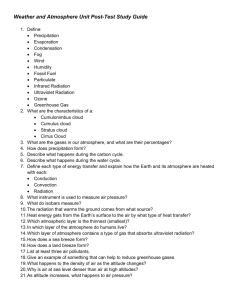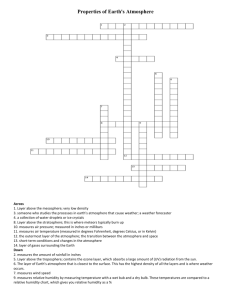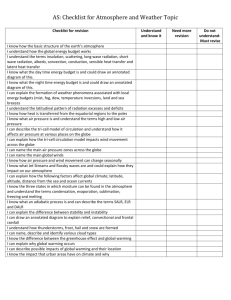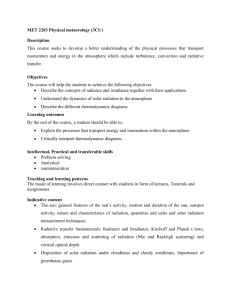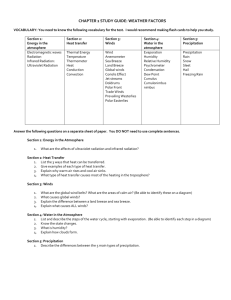1. Base your answer to the following question
advertisement
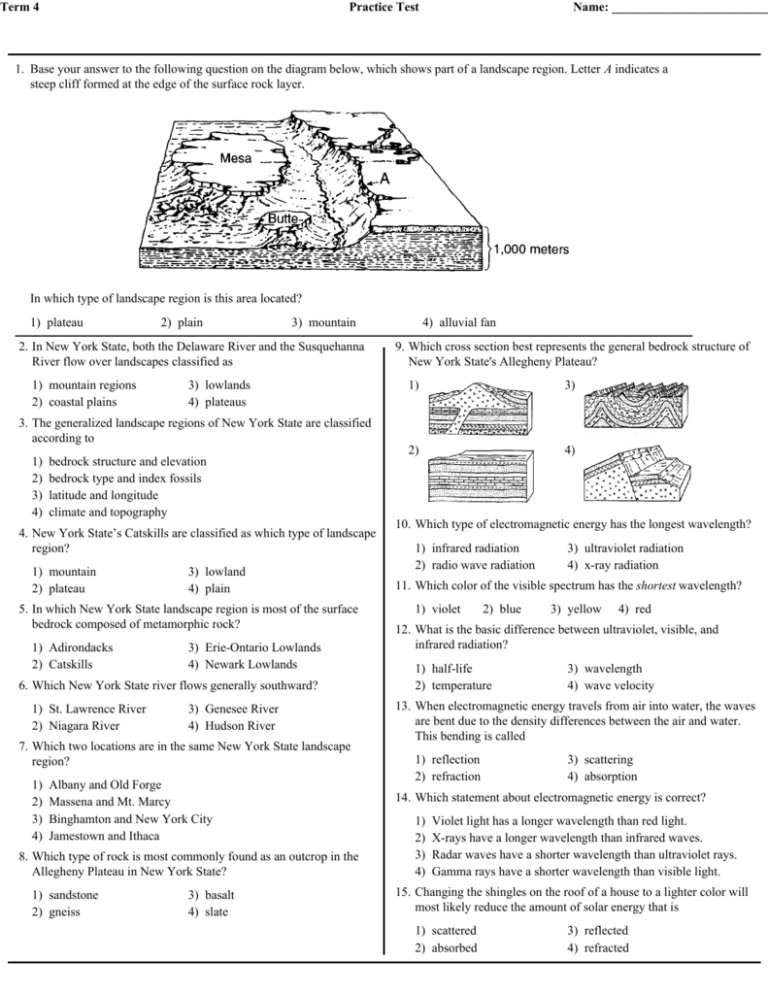
Term 4 Practice Test Name: _________________________ 1. Base your answer to the following question on the diagram below, which shows part of a landscape region. Letter A indicates a steep cliff formed at the edge of the surface rock layer. In which type of landscape region is this area located? 1) plateau 2) plain 3) mountain 2. In New York State, both the Delaware River and the Susquehanna River flow over landscapes classified as 1) mountain regions 2) coastal plains 3) lowlands 4) plateaus 3. The generalized landscape regions of New York State are classified according to 1) 2) 3) 4) bedrock structure and elevation bedrock type and index fossils latitude and longitude climate and topography 4. New York State’s Catskills are classified as which type of landscape region? 1) mountain 2) plateau 3) lowland 4) plain 5. In which New York State landscape region is most of the surface bedrock composed of metamorphic rock? 1) Adirondacks 2) Catskills 3) Erie-Ontario Lowlands 4) Newark Lowlands 6. Which New York State river flows generally southward? 1) St. Lawrence River 2) Niagara River 3) Genesee River 4) Hudson River 7. Which two locations are in the same New York State landscape region? 1) 2) 3) 4) Albany and Old Forge Massena and Mt. Marcy Binghamton and New York City Jamestown and Ithaca 8. Which type of rock is most commonly found as an outcrop in the Allegheny Plateau in New York State? 1) sandstone 2) gneiss 3) basalt 4) slate 4) alluvial fan 9. Which cross section best represents the general bedrock structure of New York State's Allegheny Plateau? 1) 3) 2) 4) 10. Which type of electromagnetic energy has the longest wavelength? 1) infrared radiation 2) radio wave radiation 3) ultraviolet radiation 4) x-ray radiation 11. Which color of the visible spectrum has the shortest wavelength? 1) violet 2) blue 3) yellow 4) red 12. What is the basic difference between ultraviolet, visible, and infrared radiation? 1) half-life 2) temperature 3) wavelength 4) wave velocity 13. When electromagnetic energy travels from air into water, the waves are bent due to the density differences between the air and water. This bending is called 1) reflection 2) refraction 3) scattering 4) absorption 14. Which statement about electromagnetic energy is correct? 1) 2) 3) 4) Violet light has a longer wavelength than red light. X-rays have a longer wavelength than infrared waves. Radar waves have a shorter wavelength than ultraviolet rays. Gamma rays have a shorter wavelength than visible light. 15. Changing the shingles on the roof of a house to a lighter color will most likely reduce the amount of solar energy that is 1) scattered 2) absorbed 3) reflected 4) refracted 16. What happens to most of the sunlight that strikes a dark-colored area of the Earth's surface? 1) 2) 3) 4) It is reflected and scattered as potential energy. It is reflected and diffused as ultraviolet radiation. It is absorbed and reflected as light. It is absorbed and reradiated as heat. 22. The cross section below shows two compartments of water of equal volume insulated by Styrofoam and separated by a metal dividing wall, forming a closed energy system. 17. Most of the solar radiation absorbed by Earth’s surface is later radiated back into space as which type of electromagnetic radiation? 1) x ray 2) ultraviolet 3) infrared 4) radio wave 18. Scientists are concerned about the decrease in ozone in the upper atmosphere primarily because ozone protects life on Earth by absorbing certain wavelengths of 1) x-ray radiation 2) ultraviolet radiation 3) infrared radiation 4) microwave radiation 19. The diagram below shows the types of electromagnetic energy given off by the Sun. The shaded part of the diagram shows the approximate amount of each type actually reaching Earth's surface. When the temperature of the water in compartment A decreases by 10°C, the temperature of the water in compartment B will 1) 2) 3) 4) Which conclusion is best supported by the diagram? 1) All types of electromagnetic energy reach Earth's surface. 2) Gamma rays and x-rays make up the greatest amount of electromagnetic energy reaching Earth's surface. 3) Visible light makes up the greatest amount of electromagnetic energy reaching Earth's surface. 4) Ultraviolet and infrared radiation make up the greatest amount of electromagnetic energy reaching Earth's surface. remain unchanged decrease by only 5°C decrease by approximately 10°C increase by approximately 10°C 23. Base your answer to the following question on the diagram below. The diagram shows the pattern of air movement within a closed room. 20. Energy is transferred from the Sun to Earth mainly by 1) molecular collisions 2) density currents 3) electromagnetic waves 4) red shifts 21. The diagram below shows a solid iron bar that is being heated in a flame. What color should the heat source in the room be painted in order to radiate the most heat? 1) red 2) black 3) green 4) silver 24. Water vapor crystallizes in the atmosphere to form snowflakes. Which statement best describes the exchange of heat energy during this process? The primary method of heat transfer in the solid iron bar is 1) convection 2) conduction 3) absorption 4) advection 1) Heat energy is transferred from the atmosphere to the water vapor. 2) Heat energy is released from the water vapor into the atmosphere. 3) Heat energy is transferred equally to and from the water vapor. 4) No heat energy is exchanged between the atmosphere and the water vapor. 25. Base your answer to the following question on the cross section below and on your knowledge of Earth science. The cross section shows the general movement of air within a portion of Earth’s atmosphere located between 30° N and 30° S latitude. Numbers 1 and 2 represent different locations in the atmosphere. The air movement shown in the cross section is due to the process of 1) condensation 2) conduction 3) evaporation 26. During which phase change will the greatest amount of energy be absorbed by 1 gram of water? 1) melting 2) freezing 4) convection 34. The diagram below shows a greenhouse. 3) evaporation 4) condensation 27. When 1 gram of liquid water at 0° Celsius freezes to form ice, how many total Joules of heat are lost by the water? 1) 4.18 2) 2.11 3) 334 4) 2260 28. Which phase change requires water to gain 2260 Joules per gram? 1) solid ice melting 2) liquid water freezing 3) liquid water vaporizing 4) water vapor condensing 29. What is the heat energy required to change 2 grams of liquid water at 100ºC to water vapor at 100ºC? 1) 334 J 2) 668 J 3) 2260 J 4) 4520 J 30. Earth’s atmosphere is warmed when 1) ultraviolet radiation emitted by Earth is absorbed by nitrogen and carbon dioxide in the atmosphere 2) x-ray radiation emitted by Earth is absorbed by nitrogen and carbon dioxide in the atmosphere 3) infrared radiation emitted by Earth is absorbed by carbon dioxide and water vapor in the atmosphere 4) gamma radiation emitted by Earth is absorbed by carbon dioxide and water vapor in the atmosphere 31. What is the relative humidity when the dry-bulb temperature is 16°C and the wet-bulb temperature is 14°C? 1) 90% 2) 80% 3) 14% 4) 13% 32. Which weather variable can be determined by using a psychrometer? 1) barometric pressure 2) cloud cover 3) relative humidity 4) wind speed 33. Which gas in the atmosphere has the most influence on day-to-day weather changes? 1) ozone 2) oxygen 3) water vapor 4) carbon dioxide What is the primary function of the clear glass of the greenhouse? 1) The glass reduces the amount of insolation entering the greenhouse. 2) The glass allows all wavelengths of radiation to enter and all wavelengths of radiation to escape. 3) The glass allows short wavelengths of radiation to enter, but reduces the amount of longwavelength radiation that escapes. 4) The glass allows long wavelengths of radiation to enter, but reduces the amount of shortwavelength radiation that escapes. 35. A student uses a sling psychrometer outdoors on a clear day. The dry-bulb (air) temperature is 10°C. The water on the wet bulb will most likely 1) condense, causing the wet-bulb temperature to be higher than the air temperature 2) condense, causing the wet-bulb temperature to be equal to the air temperature 3) evaporate, causing the wet-bulb temperature to be lower than the air temperature 4) evaporate, causing the wet-bulb temperature to be equal to the air temperature 36. The diagram below represents the path of visible light as it travels from air to water to air through a glass container of water. 40. All of the containers shown below contain the same volume of water and are at room temperature. In a two-day period, from which container will the least amount of water evaporate? 1) 3) 4) 2) The light did not travel in a straight line because of 1) convection 2) scattering 3) absorption 4) refraction 37. The arrows in the block diagram below show the movement of water after it has fallen as precipitation. 41. Liquid water will continue to evaporate from the Earth's surface, increasing the amount of atmospheric water vapor, until 1) 2) 3) 4) transpiration occurs the relative humidity falls below 50% the atmosphere becomes saturated the temperature of the atmosphere becomes greater than the dewpoint temperature 42. When a person leaves the ocean after swimming on a windy day, the person usually feels cold because 1) 2) 3) 4) water evaporates from the skin water condenses on the skin salt is absorbed through the skin radiation is absorbed through the skin 43. On a cold winter day, the air temperature is 2°C and the wet-bulb temperature is –1°C. What is the relative humidity at this location? 1) 6% Which arrow indicates the process of transpiration? 1) 1 2) 2 3) 3 4) 4 2) 37% 3) 51% 4) 83% 44. The graph below shows the average concentration of ozone in Earth's atmosphere over Arizona during 4 months of the year. 38. A container of water is placed in an open outdoor area so that the evaporation rate can be observed. The water will most likely evaporate fastest when the weather is 1) cool, humid, and windy 2) cool, dry, and calm 3) warm, humid, and calm 4) warm, dry, and windy 39. Which graph best represents the relationship between the moisture-holding capacity (ability to hold moisture) of the atmosphere and atmospheric temperature? 1) 2) 3) 4) Which layer of Earth's atmosphere contains the greatest concentration of ozone? 1) troposphere 2) stratosphere 3) mesosphere 4) thermosphere 45. Which weather instrument has most improved the accuracy of weather forecasts over the past 40 years? 1) thermometer 2) sling psychrometer 3) weather satellite 4) weather balloon 46. Why do most clouds form in the troposphere? 1) Air pressure rises with increasing altitude. 2) The dewpoint is too high in the other layers of the atmosphere. 3) The other layers of the atmosphere are too cold to contain water. 4) The lowest 11 km of the atmosphere contains almost all of the atmospheric water vapor. 47. Which circle graph best represents the volume of gases in the troposphere? 1) 3) 51. Which list correctly matches each instrument with the weather variable it measures? 1) wind vane—wind speed thermometer—temperature precipitation gauge—relative humidity 2) wind vane—wind direction thermometer—dewpoint psychrometer—air pressure 3) barometer—relative humidity anemometer—cloud cover precipitation gauge—probability of precipitation 4) barometer—air pressure anemometer—wind speed psychrometer—relative humidity 52. Which weather change is most likely indicated by rapidly falling air pressure? 2) 4) 1) 2) 3) 4) Humidity is decreasing. Temperature is decreasing. Skies are clearing. A storm is approaching. 53. Weather-station measurements indicate that the dewpoint temperature and air temperature are getting farther apart and that air pressure is rising. Which type of weather is most likely arriving at the station? 48. Which graph best represents the relationship between air temperature and elevation in the troposphere? 1) 3) 2) 4) 1) a snowstorm 2) a warm front 3) cool, dry air 4) maritime tropical air 54. The map below shows high-pressure and low-pressure weather systems in the United States. 49. Data from two weather instruments have been recorded on the graph below. Line A on the graph represents air-temperature data. Line B was plotted using the scale for variable B. Which two lettered positions on the map are most likely receiving precipitation? Line B on the graph represents data from which weather instrument? 1) thermometer 2) barometer 3) psychrometer 4) anemometer 50. Daily weather forecasts are based primarily on 1) ocean currents 2) seismic data 3) phases of the Moon 4) air-mass movements 1) A and B 2) B and D 3) C and E 4) A and D 55. Which weather conditions are most probable when the moisture content of the air increases, resulting in a lower atmospheric pressure? 1) 2) 3) 4) sunny and fair cold and windy partly cloudy, with skies becoming clear cloudy, with a chance of precipitation 56. Which map below shows the most likely storm track for a hurricane in the Atlantic Ocean? 1) 3) 2) 4) 57. Which weather station model for a New York State location indicates that snow may be about to fall? 1) 3) 59. Which weather variable generally decreases when wind speed is increasing, clouds are thickening, and visibility drops? 1) relative humidity 2) dewpoint 3) precipitation 4) air pressure 60. Which weather variable is measured by a barometer? 2) 1) dewpoint 2) wind speed 4) 3) air pressure 4) visibility 61. Air pressure is usually highest when the air is 1) cool and humid 2) cool and dry 3) warm and humid 4) warm and dry 62. Which weather variable would most likely decrease ahead of an approaching storm system? 58. A map of the United States is shown below. 1) wind speed 2) air pressure 3) cloud cover 4) relative humidity 63. The air over the Equator generally rises because the air is 1) 2) 3) 4) dry and cool with low density moist and hot with low density moist and cool with high density dry and hot with high density 64. Which feature often indicates a boundary between landscape regions? Weather conditions in which location would be of most interest to a person predicting the next day's weather for New York State? 1) A 2) B 3) C 4) D 1) 2) 3) 4) a highway cutting through a mountain region resistant bedrock composed of more than one type of mineral a long, meandering stream flowing across a large, level region a change in slope between adjoining bedrock types with different structures 65. Base your answer to the following question on the weather map below, which shows a storm system centered near the Great Lakes. Letters A through D represent weather stations shown on the map. What weather conditions are shown at location D? 1) cloudy skies with light snow 2) cloudy skies with freezing rain 3) saturated air with no precipitation 4) partly cloudy skies with rain showers 66. The weather map below shows isobars labeled in millibars. Points A, B, C, and D are locations on Earth's surface. Which location was probably experiencing the highest wind speed? 1) A 2) B 3) C 4) D Base your answers to questions 67 through 70 on the weather map below, which shows the locations of a high-pressure center (H) and a low-pressure center (L) over a portion of North America. The isolines indicate surface air pressures. 67. The arrows on which map show the most likely path in which these two pressure centers will move over the next few days? 1) 2) 3) 4) 68. The arrows on which map best show the pattern of surface winds around these two pressure centers? 1) 2) 3) 4) 69. Which map shows the most likely location of clouds associated with these pressure centers? 1) 3) 2) 4) 70. The data used to construct the isolines on this map were recorded in which units? 1) inches 2) millibars 3) feet 71. Which graph best represents the change in air pressure as air temperature increases at Earth's surface? 1) 3) 2) 4) 4) meters 73. The diagram below shows a weather instrument found at most weather stations. The main function of this instrument is to measure which weather variable? 1) wind speed 2) wind direction 72. An instrument used to measure a weather variable is shown below. 3) air pressure 4) relative humidity 74. The station model below shows several weather variables recorded at a particular location. What was the most likely dewpoint at this location? 1) 32°F Which weather variable is measured by this instrument? 1) wind direction 2) air pressure 3) wind speed 4) amount of rainfall 2) 40°F 3) 61°F 4) 70°F Base your answers to questions 75 and 76 on the weather map below, which represents a low-pressure system over New York State. The L on the map represents the center of the low-pressure system. Two fronts extend from the center of the low, and are labeled front 1 and front 2. Cloud cover has been omitted from the station models. 76. The arrows on which map best represent the surface wind pattern around this low-pressure center? 1) 2) 3) 75. Which map best represents the type of fronts and direction of movement of these fronts in relation to the low-pressure center? 4) 1) 2) 77. Which station model shows a wind direction from the southeast? 1) 3) 2) 3) 4) 4) 78. The maps below labeled A, B, and C, show three different stream drainage patterns. Which factor is primarily responsible for causing these three different drainage patterns? 1) amount of precipitation 2) bedrock structure 3) stream discharge 4) prevailing winds Base your answers to questions 79 and 80 on the weather map below, which shows a low-pressure system over the eastern United States. Letters A through D represent weather stations. 79. Surface winds within this low-pressure system most likely are flowing 1) toward the center in a clockwise pattern 2) toward the c enter in a counterclockwise pattern 3) away from the center in a clockwise pattern 4) away from the center in a counterclockwise pattern 80. Which weather instrument was used to measure wind speed at station D? 1) barometer 2) thermometer 3) psychrometer 4) anemometer Base your answers to questions 81 through 83 on on the station models below, which show various weather conditions recorded at the same time on the same day at four different cities. 81. Which weather symbol best represents the type of precipitation that was most likely occurring in Utica? 1) 2) 3) 4) 3) Buffalo 4) Utica 3) 35 knots 4) 45 knots 82. Which city had the lowest relative humidity? 1) Chicago 2) Detroit 83. Which wind speed was recorded at Detroit? 1) 15 knots 2) 25 knots 84. Weather station models for three New York State cities on the same day at the same time are shown below. Which map shows the front that was most likely passing through Rochester at that time? 86. The block diagram below shows a landscape region. Which stream drainage pattern would most likely develop at the surface of this region? 1) 1) 2) 2) 3) 3) 4) 4) 85. Which diagram represents a plateau landscape? 1) 2) 3) 4) 87. The map below shows a stream drainage pattern. Arrows show the direction of stream flow. On which landscape region did this drainage pattern most likely develop? 1) 2) 3) 4) 88. The block diagrams below show two landscape regions labeled A and B. 89. The diagram below shows a cross section of a portion of Earth's crust. Altitude is shown in meters above sea level. This landscape region is best classified as an eroded What is the most probable cause of the difference in surface features between A and B? 1) A is the result of a humid climate, while B is the result of a dry climate. 2) A is at a high elevation, while B is located at sea level. 3) A is a plateau region, while B is a mountainous region. 4) A is composed of igneous bedrock, while B is composed of sedimentary bedrock. 1) plain 2) plateau 3) domed mountain 4) folded lowland 90. The diagram below represents a cross section of the bedrock and land surface in part of Tennessee. The dotted lines indicate missing rock layers. Which statement is best supported by the diagram? 1) 2) 3) 4) Rocks are weathered and eroded evenly. Folded rocks are more easily weathered and eroded. Deposits of sediments provide evidence of erosion. Climate differences affect the amount of erosion. 91. The cross section below shows sedimentary bedrock layers A, B, C, and D exposed at Earth's surface. Which layer appears to be the least resistant to weathering? 1) A 2) B 3) C 4) D Answer Key term 4 2014 practice 1. 1 42. 1 83. 2 2. 4 43. 3 84. 2 3. 1 44. 2 85. 2 4. 2 45. 3 86. 1 5. 1 46. 4 87. 3 6. 4 47. 1 88. 1 7. 4 48. 1 89. 2 8. 1 49. 2 90. 2 9. 2 50. 4 91. 1 10. 2 51. 4 11. 1 52. 4 12. 3 53. 3 13. 2 54. 2 14. 4 55. 4 15. 2 56. 2 16. 4 57. 1 17. 3 58. 2 18. 2 59. 4 19. 3 60. 3 20. 3 61. 2 21. 2 62. 2 22. 4 63. 2 23. 2 64. 4 24. 2 65. 2 25. 4 66. 2 26. 3 67. 4 27. 3 68. 1 28. 3 69. 2 29. 4 70. 2 30. 3 71. 2 31. 2 72. 3 32. 3 73. 2 33. 3 74. 3 34. 3 75. 1 35. 3 76. 3 36. 4 77. 2 37. 2 78. 2 38. 4 79. 2 39. 2 80. 4 40. 1 81. 4 41. 3 82. 1
